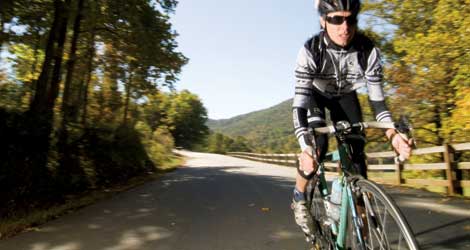Preparing for the season
Canada's national road cycling coach says it's time to look ahead to the racing season.

Whether you’ve ridden an indoor trainer, braved the inclement weather outside or resorted to doing a little cross training to keep fit through the winter, Canada’s national road cycling coach says it’s time to look ahead to the racing season. Vincent Jourdain has been at the helm of the national program since 2005 and is preparing the national team for the 2010 season. The primary targets will be the UCI Road Cycling Championships in Australia (September 29 to October 3) and the Commonwealth Games in Delhi, India a week later.
Jourdain said most of his athletes will be covering between 800 km and 1,000 km a week in their pre-season training. While most of us can’t commit the same 15 to 20 hours a week, we can still benefit from their system.
“As they get closer to the racing season there’s a lot of interval training,” he said. “We will work on maximum aerobic power. The best way to develop this is by doing two interval sessions a week at maximum aerobic power. There could be a lot of mileage as well.”
Jourdain’s riders warm up on the bike for 20 to 30 minutes and then go hard for four minutes before easing off for four minutes. They will repeat this three times. By doing this the cyclists are getting close to 100 per cent of their maximum aerobic power. After 10 minutes, they repeat the procedure three more times. To end a session like this, he recommends at least a 20-minute cool down.
“It might be two hours or more on the bike,” Jourdain said. “It’s really important to keep in mind that a key factor of training is rest. There’s no increase in training without rest. They will go home and eat, then have a nap. Later in the day they might go out for a little spin, which helps them recover from the training in the morning.”
If someone is just getting re-acquainted with the bike, Jourdain advises getting out in a group for an hour or two every day for a few weeks. This is to lay a foundation for harder training later. Those who are racing 150km or more are eventually going to need to add one or two long rides of four hours or more each week. If this all sounds a bit intimidating, Jourdain says not to worry. Some recent studies have shown interval training can help increase a cyclist’s endurance base. “Maybe you have an hour during lunchtime or at the end of the day. Then you want to be specific,” he says. “It means you don’t have to ride at a slow place for an hour and a half before you get some results.”
Jourdain borrows something called 50-50 training from cross-country skiers. The athletes ride hard for 50 seconds then ease off for 50 seconds, repeating it for eight to 10 minutes. They will repeat this after a short recovery break. It’s a workout that can be done in an hour.
“You choose a good terrain to do this,” Jourdain says. “You’re not doing this on the hills, you are on flat terrain, without wind if possible and without a big gear. You need to manage your intensity. “That is the new philosophy. It means you don’t have to wait a month doing slow long distances before introducing interval training to increase fitness.”
No matter which way a cyclist goes in the spring training schedule, the coach cautions against going too hard too soon.”If you do a really hard ride you can do a long ride the day after, but easy,” he says, “Stay in the pack and benefit from the group.”
Paul Gains is a freelance writer based in Cambridge, Ontario
